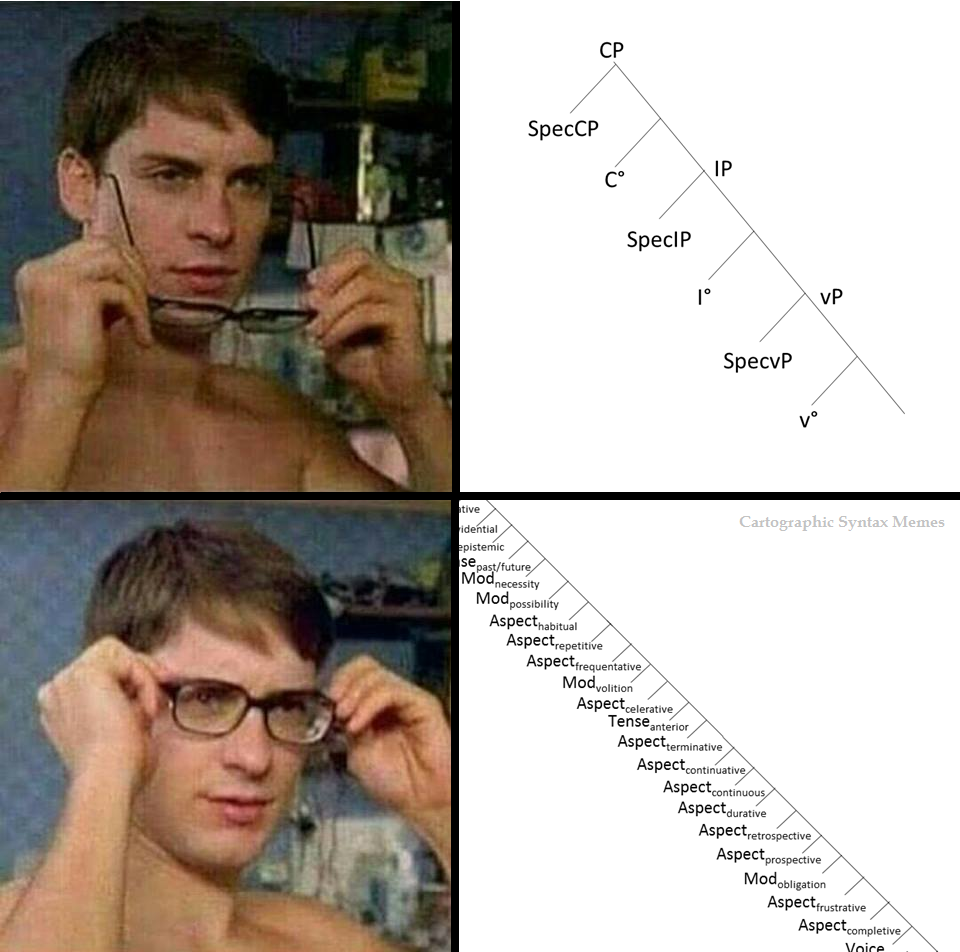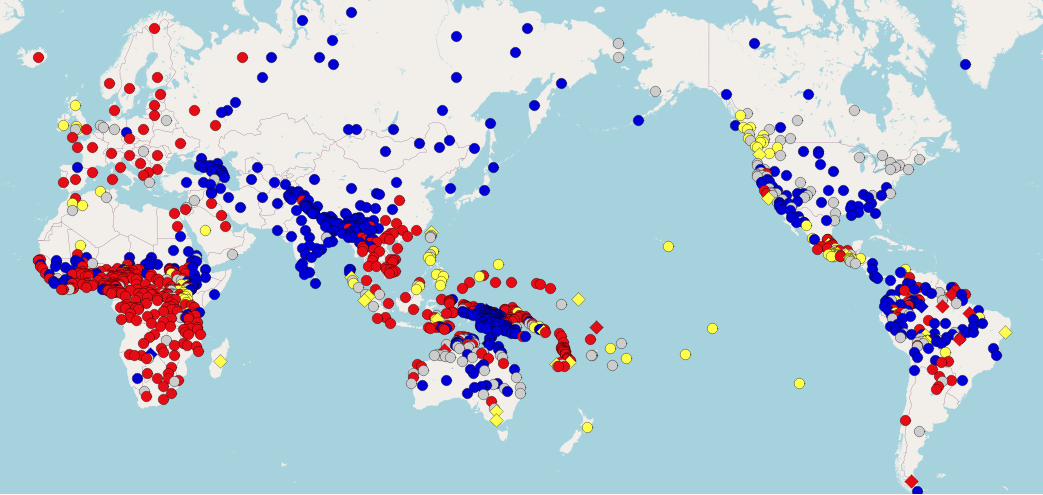
Syntax
Ponrawee Prasertsom
LOT Training Camp 2025
Heads and dependents
Phrases in languages almost always have heads, which carry the core meanings.
- Noun phrase: big cars
- Verb phrase: walk slowly
- Adposition phrase: to me (preposition), Tokyou kara (postposition)
- Adjective phrase: really good
Head directionality
- Heads often consistently occur phrase-initially or -finally.
- For example, Thai is consistently head-initial:
- บ้านหลังใหญ่
- บ้านที่ฉันอยู่
- เดินช้า ๆ
- แก่ฉัน-
- But this is not necessary. English, for example, is usually head-initial, but most adjectives come before nouns.
- a big house
- the house that I live in
Morphosyntactic alignment
In English, we have different Subject and Object pronouns:
- They are walking.
- He hated them.
In languages with more elaborate case systems, nouns in general can have different Subject and Object forms (case), as in Latvian, which uses case suffixes:
putn-s
bird-SBJ
lidoja
fly.PST.3
putn-s lidoja
bird-SBJ fly.PST.3
‘The bird was flying.’
bērn-s
child-SBJ
zīmē
draw.PRES.3
sun-i
dog-OBJ
bērn-s zīmē sun-i
child-SBJ draw.PRES.3 dog-OBJ
‘The child is drawing a dog.’
NACLO 2009, Round 2, Dyirbal
However, in Dyirbal, intransitive Subject nouns and determiners (bayi) have the same form as transitive Objects.
bayi
DEF
ŋuma
father
ñinañu
sit.PST
bayi ŋuma ñinañu
DEF father sit.PST
‘The father sat.’
bayi
DEF
ŋuma
father
baŋgul
DEF
ñalŋgaŋgu
boy
bur̹an
see.PST
bayi ŋuma baŋgul ñalŋgaŋgu bur̹an
DEF father DEF boy see.PST
‘The boy saw the father.’
NACLO 2009, Round 2, Dyirbal
However, in Dyirbal, intransitive Subject nouns and determiners (bayi) have the same form as transitive Objects.
bayi
DEF
ŋuma
father
ñinañu
sit.PST
bayi ŋuma ñinañu
DEF father sit.PST
‘The father sat.’
bayi
DEF
ŋuma
father
baŋgul
DEF
ñalŋgaŋgu
boy
bur̹an
see.PST
bayi ŋuma baŋgul ñalŋgaŋgu bur̹an
DEF father DEF boy see.PST
‘The boy saw the father.’
... and the transitive Subject has a different form.
ŋinda
2SG
bayi
DEF
ñalŋga
boy
walmbin
wake.PST
ŋinda bayi ñalŋga walmbin
2SG DEF boy wake.PST
‘You woke the boy.’
Subject/Object forms are no longer across across sentences.
Morphosyntactic alignment
Linguists often work with S, A, O instead of Subjects and Objects.
- S(ubject) = Subject of intransitives
- A(gent) = Subject of transitives
- O(bject) = Object of transitives
Common systems:
- Nominative-accusative: S=A≠O English, Japanese, French, Latvian, Hungarian, ...
- Ergative-absolutive: S=O≠A Dyirbal, Hunzib, Basque, Tibetan, Georgian, ...
Morphosyntactic alignment
Real languages are not neat. Languages often have split systems, based on other features. Common features are:
- Verb meaning: In Central Pomo, S=A if the verb is agentive. S=O if the verb is not agentive.
ʔa·
1SG.SA
qʰadé·č’
fight
ʔa· qʰadé·č’
1SG.SA fight
‘I fight.’
ʔa·
1SG.A
mú·tu̪
3SG.O
ʔé·čyadiw
chase_away
ʔa· mú·tu̪ ʔé·čyadiw
1SG.A 3SG.O chase_away
‘I chased him/her away.’
t̪o·
1SG.SO
ló·ya
fall
t̪o· ló·ya
1SG.SO fall
‘I fell.’
mu·l
3SG.A
t̪o·
1SG.O
ʔé·čyadiw
chase_away
mu·l t̪o· ʔé·čyadiw
3SG.A 1SG.O chase_away
‘He chased me away.’
Morphosyntactic alignment
Real languages are not neat. Languages often have split systems, based on other features. Common features are:
- Noun type: In Maragny, pronouns follow S=A≠O, but nouns follow S=O≠A.
matya
before
ngaya
1SG.A
balgangandala
hit.HAB.PST
yurdi
meat.O
matya ngaya balgangandala yurdi
before 1SG.A hit.HAB.PST meat.O
‘I used to kill a lot of kangaroos.’
ngaya
1SG.S
nhunu
always
wabanhi
come.PRS
ngaya nhunu wabanhi
1SG.S always come.PRS
‘I always come here.’
nguda-nggu
dog-A
yurdi
meat.O
gamba:nhi
bury.REC.PST
nguda-nggu yurdi gamba:nhi
dog-A meat.O bury.REC.PST
‘The dog buried the meat.’
nguda
dog.S
nguna:labanhi
lie_about.PST
nguda nguna:labanhi
dog.S lie_about.PST
‘There's dogs lying around.’
Morphosyntactic alignment
Real languages are not neat. Languages often have split systems, based on other features. Common features are:
- Tense/Aspect/Mood
- Person
- Animacy
- ...
Keep your minds open!
NACLO 2017, Round 2, Proto-Algonquian
- kewa:pameθehm
- kewa:pameθehmwa:
- newa:pama:ehma
- newa:pama:ehmaki
- kewa:pameθehmwa:ena:n
- newa:pama:ehmena:na
- kewa:pamiehm
- kewa:pama:ehm
- kewa:pamiehmwa:
- kewa:pamiehmwa:ena:n
- newa:pamekwehmena:naki
- ‘I see you (sg)’
- ‘I see you (pl)’
- ‘I see him/her’
- ‘I see them’
- ‘we see you (pl)’
- ‘we see him/her’
- ‘you (sg) see me’
- ‘you (sg) see her/him’
- ‘you (pl) see me’
- ‘you (pl) see us (excl)’
- ‘they see us’
NACLO 2017, Round 2, Proto-Algonquian
- ke-wa:pam-eθ-ehm
- ke-wa:pam-eθ-ehm-wa:
- ne-wa:pam-a:-ehm-a
- ne-wa:pam-a:-ehm-aki
- ke-wa:pam-eθ-ehm-wa:-ena:n
- ne-wa:pam-a:-ehm-ena:n-a
- ke-wa:pam-i-ehm
- ke-wa:pam-a:-ehm
- ke-wa:pam-i-ehm-wa:
- ke-wa:pam-i-ehm-wa:-ena:n
- ne-wa:pam-ekw-ehm-ena:n-aki
- 1SG.A.see.2SG.O
- 1SG.A.see.2PL.O
- 1SG.A.see.3SG.O
- 1SG.A.see.3PL.O
- 1PL.A.see.2PL.O
- 1PL.A.see.3SG.O
- 2SG.A.see.1SG.O
- 2SG.A.see.3SG.O
- 2PL.A.see.1SG.O
- 2PL.A.see.1PL.EXCL.O
- 3PL.A.see.1PL.INCL.O
NACLO 2017, Round 2, Proto-Algonquian
- ke-wa:pam-eθ-ehm
- ke-wa:pam-eθ-ehm-wa:
- ne-wa:pam-a:-ehm-a
- ne-wa:pam-a:-ehm-aki
- ke-wa:pam-eθ-ehm-wa:-ena:n
- ne-wa:pam-a:-ehm-ena:n-a
- ke-wa:pam-i-ehm
- ke-wa:pam-a:-ehm
- ke-wa:pam-i-ehm-wa:
- ke-wa:pam-i-ehm-wa:-ena:n
- ne-wa:pam-ekw-ehm-ena:n-aki
- 1SG.A.see.2SG.O
- 1SG.A.see.2PL.O
- 1SG.A.see.3SG.O
- 1SG.A.see.3PL.O
- 1PL.A.see.2PL.O
- 1PL.A.see.3SG.O
- 2SG.A.see.1SG.O
- 2SG.A.see.3SG.O
- 2PL.A.see.1SG.O
- 2PL.A.see.1PL.EXCL.O
- 3PL.A.see.1PL.INCL.O
- -eθ- = 1.A → 2.O
NACLO 2017, Round 2, Proto-Algonquian
- ke-wa:pam-eθ-ehm
- ke-wa:pam-eθ-ehm-wa:
- ne-wa:pam-a:-ehm-a
- ne-wa:pam-a:-ehm-aki
- ke-wa:pam-eθ-ehm-wa:-ena:n
- ne-wa:pam-a:-ehm-ena:n-a
- ke-wa:pam-i-ehm
- ke-wa:pam-a:-ehm
- ke-wa:pam-i-ehm-wa:
- ke-wa:pam-i-ehm-wa:-ena:n
- ne-wa:pam-ekw-ehm-ena:n-aki
- 1SG.A.see.2SG.O
- 1SG.A.see.2PL.O
- 1SG.A.see.3SG.O
- 1SG.A.see.3PL.O
- 1PL.A.see.2PL.O
- 1PL.A.see.3SG.O
- 2SG.A.see.1SG.O
- 2SG.A.see.3SG.O
- 2PL.A.see.1SG.O
- 2PL.A.see.1PL.EXCL.O
- 3PL.A.see.1PL.INCL.O
- -eθ- = 1.A → 2.O
- -a:- = 1.A, 2.A → 3.O
- -i- = 2.A → 1.O
- -ekw- = 3.A → 1.O
NACLO 2017, Round 2, Proto-Algonquian
- ke-wa:pam-eθ-ehm
- ke-wa:pam-eθ-ehm-wa:
- ne-wa:pam-a:-ehm-a
- ne-wa:pam-a:-ehm-aki
- ke-wa:pam-eθ-ehm-wa:-ena:n
- ne-wa:pam-a:-ehm-ena:n-a
- ke-wa:pam-i-ehm
- ke-wa:pam-a:-ehm
- ke-wa:pam-i-ehm-wa:
- ke-wa:pam-i-ehm-wa:-ena:n
- ne-wa:pam-ekw-ehm-ena:n-aki
- 1SG.A.see.2SG.O
- 1SG.A.see.2PL.O
- 1SG.A.see.3SG.O
- 1SG.A.see.3PL.O
- 1PL.A.see.2PL.O
- 1PL.A.see.3SG.O
- 2SG.A.see.1SG.O
- 2SG.A.see.3SG.O
- 2PL.A.see.1SG.O
- 2PL.A.see.1PL.EXCL.O
- 3PL.A.see.1PL.INCL.O
- -eθ- = 1.A → 2.O
- -a:- = 1.A, 2.A → 3.O
- -i- = 2.A → 1.O
- -ekw- = 3.A → 1.O
- -wa: = 2PL
NACLO 2017, Round 2, Proto-Algonquian
- ke-wa:pam-eθ-ehm
- ke-wa:pam-eθ-ehm-wa:
- ne-wa:pam-a:-ehm-a
- ne-wa:pam-a:-ehm-aki
- ke-wa:pam-eθ-ehm-wa:-ena:n
- ne-wa:pam-a:-ehm-ena:n-a
- ke-wa:pam-i-ehm
- ke-wa:pam-a:-ehm
- ke-wa:pam-i-ehm-wa:
- ke-wa:pam-i-ehm-wa:-ena:n
- ne-wa:pam-ekw-ehm-ena:n-aki
- 1SG.A.see.2SG.O
- 1SG.A.see.2PL.O
- 1SG.A.see.3SG.O
- 1SG.A.see.3PL.O
- 1PL.A.see.2PL.O
- 1PL.A.see.3SG.O
- 2SG.A.see.1SG.O
- 2SG.A.see.3SG.O
- 2PL.A.see.1SG.O
- 2PL.A.see.1PL.EXCL.O
- 3PL.A.see.1PL.INCL.O
- -eθ- = 1.A → 2.O
- -a:- = 1.A, 2.A → 3.O
- -i- = 2.A → 1.O
- -ekw- = 3.A → 1.O
- -wa: = 2PL
- -ena:n = 1PL
- -a, -aki = 3SG, 3PL
- -∅ = 1SG, 2SG
NACLO 2017, Round 2, Proto-Algonquian
- ke-wa:pam-eθ-ehm
- ke-wa:pam-eθ-ehm-wa:
- ne-wa:pam-a:-ehm-a
- ne-wa:pam-a:-ehm-aki
- ke-wa:pam-eθ-ehm-wa:-ena:n
- ne-wa:pam-a:-ehm-ena:n-a
- ke-wa:pam-i-ehm
- ke-wa:pam-a:-ehm
- ke-wa:pam-i-ehm-wa:
- ke-wa:pam-i-ehm-wa:-ena:n
- ne-wa:pam-ekw-ehm-ena:n-aki
- 1SG.A.see.2SG.O
- 1SG.A.see.2PL.O
- 1SG.A.see.3SG.O
- 1SG.A.see.3PL.O
- 1PL.A.see.2PL.O
- 1PL.A.see.3SG.O
- 2SG.A.see.1SG.O
- 2SG.A.see.3SG.O
- 2PL.A.see.1SG.O
- 2PL.A.see.1PL.EXCL.O
- 3PL.A.see.1PL.INCL.O
- -eθ- = 1.A → 2.O
- -a:- = 1.A, 2.A → 3.O
- -i- = 2.A → 1.O
- -ekw- = 3.A → 1.O
- -wa: = 2PL
- -ena:n = 1PL
- -a, -aki = 3SG, 3PL
- -∅ = 1SG, 2SG
- ne- = 1 and 3
- ke- = 2
NACLO 2017, Round 2, Proto-Algonquian
Algonquian languages have the direct-inverse voice system. This kind of system cares about the Person feature of both A and O.
(Note that there is another equally valid answer that does not make use of the direct-inverse system, but the real system is a direct-inverse one.)
Valence-decreasing: Passive
We are all familiar with the passive voice in English:
- He pushed her.
- She was pushed (by him). (passive)
In terms of alignment, the passive is A-demotion.
- A is omitted or becomes an Oblique (she → by her).
- O becomes S (her → she).
- The verb becomes intransitive.
Valence-decreasing: Antipassive
There is something similar in ergative languages (S=O≠A). This is the antipassive.
yero-m
Yero-A
keme-q
meat-O
nere-llru-a
eat-PST-3SG.A:3SG.O
yero-m keme-q nere-llru-a
Yero-A meat-O eat-PST-3SG.A:3SG.O
‘Yero ate the meat.’
yero-q
Yero-S
(kemer-meng)
meat-INS
nere-llru-u-q
eat-PST-INTR-3SG
yero-q (kemer-meng) nere-llru-u-q
Yero-S meat-INS eat-PST-INTR-3SG
‘Yero ate (the meat).’
The antipassive is O-demotion.
- O is omitted or becomes an Oblique (keme-q → kemer-meng).
- A becomes S (yero-m → yero-q).
Valence-increasing: Causative
Some languages have causative forms that add the meaning ‘‘make sb V’’ to a verb. Examples from Quechua:
noqa
1SG
puñu-u
sleep-1SG
noqa puñu-u
1SG sleep-1SG
‘I sleep.’
∅
3SG.A
noqa-ta
1SG-O
puñu-chi-ma-n
sleep-CAUS-1SG.O-3SG.A
∅ noqa-ta puñu-chi-ma-n
3SG.A 1SG-O sleep-CAUS-1SG.O-3SG.A
‘It makes me sleep.’
Valence-increasing: Applicative
Obliques get promoted to O (rá-viimú → -ra)
In Yagua, the Oblique occurs as a separate word:
sa-duu
3SG-blow
rá-viimú
INAN-into
sa-duu rá-viimú
3SG-blow INAN-into
‘He blows into it.’
When the verb is in the applicative, O-agreement suffix (technically, clitic) occurs with the verb.
sa-duu-ta-ra
3SG.A-blow-APPL-INAN.O
sa-duu-ta-ra
3SG.A-blow-APPL-INAN.O
‘He blows it.’
Valence-increasing: Applicative
Applicatives may also occur with transitive verbs. This makes them ditransitives and add meaning such as, 'for someone'.
In Kinyawarda,
umukôobwa
girl
a-rá-som-er-a
3SG.F-PROG-read-BEN.APPL-ASP
umuhuûngu
boy
igitabo
book
umukôobwa a-rá-som-er-a umuhuûngu igitabo
girl 3SG.F-PROG-read-BEN.APPL-ASP boy book
‘The girl is reading the boy a book (= the girl is reading a book for the boy).’
